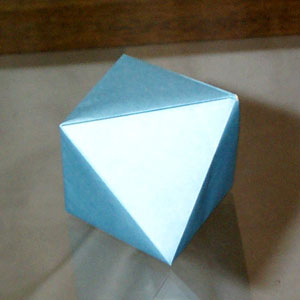The regular octahedron, often simply called "the" octahedron, is the Platonic solid with six polyhedron
vertices, 12 polyhedron edges, and eight equivalent
equilateral triangular faces, denoted . It is illustrated above together
with a wireframe version and a net that can be used for its
construction.
The regular octahedron is also the uniform polyhedron with Maeder index 5 (Maeder 1997), Wenninger index 2 (Wenninger 1989), Coxeter index
17 (Coxeter et al. 1954), and Har'El index 10 (Har'El 1993). It is given by
the Schläfli symbol and Wythoff symbol
. The octahedron of unit side length
is the antiprism of
sides with height
(i.e., the regular triangular antiprism).
The octahedron is also a square dipyramid with
equal edge lengths.
A number of symmetric projections of the regular octahedron are illustrated above.
The regular octahedron is implemented in the Wolfram Language as Octahedron[] or UniformPolyhedron["Octahedron"]. Precomputed properties are available as PolyhedronData["Octahedron", prop].
There are 11 distinct nets for the octahedron, the same as for the cube (Buekenhout and Parker 1998). Questions of polyhedron coloring of the octahedron can be addressed using the Pólya enumeration theorem.
The octahedron is the convex hull of the tetrahemihexahedron.
The dual polyhedron of an octahedron with unit edge lengths is a cube with edge lengths .

The illustration above shows an origami octahedron constructed from a single sheet of paper (Kasahara and Takahama 1987, pp. 60-61).
Like the cube, the regular octahedron has the octahedral group of
symmetries.
The connectivity of the vertices is given by the octahedral graph.
|
|
|
The regular octahedron has a single stellation: the stella octangula. The solid bounded by the two tetrahedra of the stella octangula (left figure) is a regular octahedron (right figure; Ball and Coxeter 1987).
S. Wagon (pers. comm., Oct. 30, 2013) has constructed a closed loop of eight regular octahedra.
The following table gives polyhedra which can be constructed by augmentation of a regular octahedron by pyramids of given heights .
Three orientations of a regular octahedron are illustrated above. The left one has vertices ,
,
,
(for edge lengths
),
the middle one has vertices
,
,
(for edge lengths
), and the right one has vertices
and
(for edge lengths
).
In the former case, the face planes are , so a solid octahedron is given by the equation
|
(1)
|
If the edges of a regular octahedron are divided in the golden ratio such that the points of division for any face form an equilateral triangle, then the twelve points of division form an icosahedron (Wells 1991). In fact, there are two ways in which the edges can be internally divided in the golden ratio and two ways in which they can be externally divided, resulting in four possible icosahedra. Keeping the same connectivity, but reversing the long and short ends of the division gives Jessen's orthogonal icosahedron.
A plane perpendicular to a axis of an octahedron cuts the solid in a regular hexagonal cross section (Holden 1991, pp. 22-23). Since
there are four such axes, there are four possible hexagonal cross sections.
|
|
|
The centers of the faces of a regular octahedron form a cube, and the centers of the faces of a cube form an octahedron (Steinhaus 1999, pp. 194-195). Faceted forms of the regular octahedron include the cubitruncated cuboctahedron and tetrahemihexahedron.
Let a regular octahedron be length on a side. The height of the top polyhedron
vertex from the square plane is also the circumradius
|
(2)
|
where
|
(3)
|
is the diagonal length, so
|
(4)
|
Now compute the inradius.
|
(5)
| |||
|
(6)
| |||
|
(7)
|
so
|
(8)
|
Use similar triangles to obtain
|
(9)
| |||
|
(10)
| |||
|
(11)
|
so the inradius is
|
(12)
|
and twice the inradius gives the height of the octahedron viewed as a 3-sided antiprism. The midradius of the octahedron is
|
(13)
|
The area of one face of a regular octahedron is the area of an equilateral triangle
|
(14)
|
The volume is two times the volume of a square-base pyramid,
|
(15)
|
The dihedral angle is
|
(16)
|
and the Dehn invariant of a unit regular octahedron is
|
(17)
| |||
|
(18)
| |||
|
(19)
|
(OEIS A377296), where the first expression uses the basis of Conway et al. (1999).
The regular octahedron can be built using a Haűy construction. The Haűy octahedral numbers
|
(20)
|
give another method for calculating the volume of the octahedron,
 |
(21)
|
in agreement with the result derived above.
